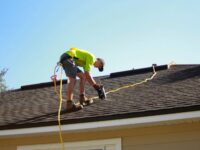The following contribution is from another author.
If you’ve got a garage, it’s important that you maintain this space just as you would with any other room in your house. A neglected garage can lead to all kinds of problems – some of which may affect the rest of your home. Even if your garage is mostly used to store clutter, it’s worth keeping an eye on the condition of your garage. Below are just a few repairs that you should never put off.
Repairing broken doors
Garage doors come in all different styles and therefore can be prone to all kinds of different forms of damage from broken springs to loose hinges to general rust. This is often the result of wear and tear – most garage doors last between 15 and 30 years before needing to be replaced.
Broken garage doors could be a major inconvenience if you regularly use your garage doors when parking your car or accessing tools. But what about if you rarely ever use your garage doors? Are they still worth repairing?
In many cases, yes. Allowing your garage door to simply decay could leave it vulnerable against a break-in. A burglar may find it easy to pry your door open or remove it, giving them access to any valuables that may be in your garage. Damage could also allow in rainwater and pests, which could result in damage to your possessions. Even a slight alignment could allow a gap large enough for rain and rodents to get in.
Broken garage doors can also be a safety risk. A broken spring or a broken cable could make a garage door unsafe to use – there could be a risk of it springing open or falling down without warning. Unless you plan to never use your garage door again, you should look into repairs to avoid any potential injury when you eventually do need to operate the door.
Garage door repairs can be complex and sometimes dangerous if you don’t know what you’re doing. You should hire an expert to repair them when possible. If your garage doors are very old and worn it could be a good time for a replacement. This garage door buying guide offers information on various different styles. Some styles of door are likely to be easier to maintain and more long-lasting than others.
Sealing up cracks
If there are cracks in the walls, ceiling or floor of your garage, you may want to consider fixing these sooner rather than later. Cracks can be caused by weather or natural movement of the building over time. In other cases, they could be the result of poor construction. In all cases, cracks will grow if you ignore them. Large cracks will start to let in water and possibly even pests, which could then result in damage to the contents of your garage. By sealing up these cracks you can prevent this.
Caulk may be a simple solution to most small cracks. When it comes to larger cracks, you may want to hire an expert to look at them. Such cracks could be a sign of subsidence and may require you to reinstall the foundations of your garage to prevent further damage. Ignoring these cracks might lead to your garage one day collapsing (and if your garage is connected to your home, you may find that the rest of your home’s structural integrity is negatively affected too). This is why you should never ignore large cracks.
Replacing a sagging roof
Another common structural problem seen in garages is a sagging roof. This could be due to incorrect installation – a lack of rafter ties could be to blame or the rafters may not be strong enough to support the type of roofing. Other things that can cause sagging include adding extra weight to your roof without installing additional support (such as adding solar panels) or wear and tear over time (water damage and termites are two common culprits that can lead to weakened rafters).
It’s worth repairing a sagging roof immediately before it collapses and destroys any possession in your garage. A sagging roof that is joined to the rest of your home could even be putting stress on the overall structure of the building, leading to further structural issues down the line.
The best way to fix a sagging roof is often to replace the entire roof completely. This should ideally be carried out by a professional roofer. Unless you’ve got experience with fixing roofing, it’s best to avoid taking on the job yourself.
















